When you step into a courtroom for a child custody hearing, your outfit speaks before you do. It’s not just about looking polished; it’s about sending a message of respect, stability, and seriousness to the judge. In modern days, where fashion trends shift faster than a TikTok algorithm, nailing courtroom attire is a delicate balance of style and strategy.
Why Clothing Choices Matter: Psychology of First Impressions
Ever notice how a sharp blazer makes you feel like you can conquer the world? That’s the psychology of first impressions at work, and it’s critical in court. Judges form opinions quickly, often within seconds, based on your appearance. A tailored navy suit or a modest knee-length dress signals responsibility and parental capability, while a sloppy or overly flashy outfit might scream “I’m not taking this seriously.” Studies show that people associate neat, professional attire with trustworthiness—exactly the vibe you want when fighting for custody. Your outfit isn’t just fabric; it’s a visual handshake with the court.
Respect for the courtroom matters too. Dressing appropriately shows you understand the gravity of the situation. Think of it like showing up to a job interview: you wouldn’t wear flip-flops, right? The same logic applies here. A crisp blouse and structured trousers tell the judge you’re invested in the outcome, not just physically present.
Legal Implications of Inappropriate Dressing
Wearing the wrong thing to court isn’t just a fashion faux pas—it can have real consequences. Courts have strict dress codes, and violating them risks penalties or even dismissal. Exposed midriffs, hats, or loud graphic tees? They’re on the banned list in most jurisdictions. In 2010, Jennifer LaPenta was briefly jailed for contempt in Lake County, Illinois, after refusing to remove a T-shirt that the presiding judge deemed “offensive,” illustrating how judges have limited tolerance for attire they consider disruptive
These aren’t scare tactics; they’re reality checks. Dressing inappropriately can distract from your case or worse, make the judge question your decision-making skills. Why risk it? A simple, elegant outfit—like a gray sheath dress paired with low heels—keeps the focus on your words, not your wardrobe.
1.

Recently, “coastal cool” stripes and textured knits are trending, you can stay stylish without crossing the line. The courtroom isn’t your runway, but it’s still a stage where every detail counts.
Essential Wardrobe Pieces for Moms: Timeless Court-Appropriate Outfits
Stepping into a child custody courtroom feels like walking onto a stage where every detail is scrutinized. Your outfit? It’s your costume, signaling respect, stability, and readiness to parent. Let’s unpack the must-have wardrobe pieces for moms that blend timeless elegance with court-approved polish, ensuring you shine without stealing the spotlight.
The Power Suit: Tailored Blazers, Pants, and Modest Dresses
Nothing says “I’ve got this” like a tailored power suit. A well-fitted blazer in navy, gray, or black paired with matching trousers or a pencil skirt is your courtroom superhero cape. These neutral tones project authority and calm, while structured silhouettes flatter without distracting.
2.
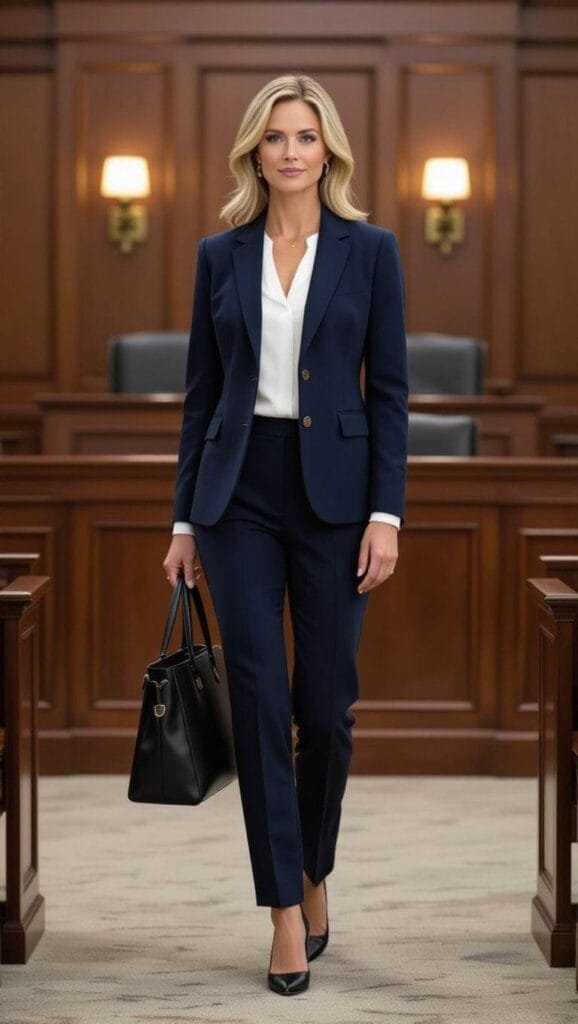
Opt for wool or cotton blends—breathable, polished, and wrinkle-resistant for those long hearing days. A sheath dress in a muted color, like charcoal or taupe, is another winner; its clean lines scream sophistication without trying too hard.
3.
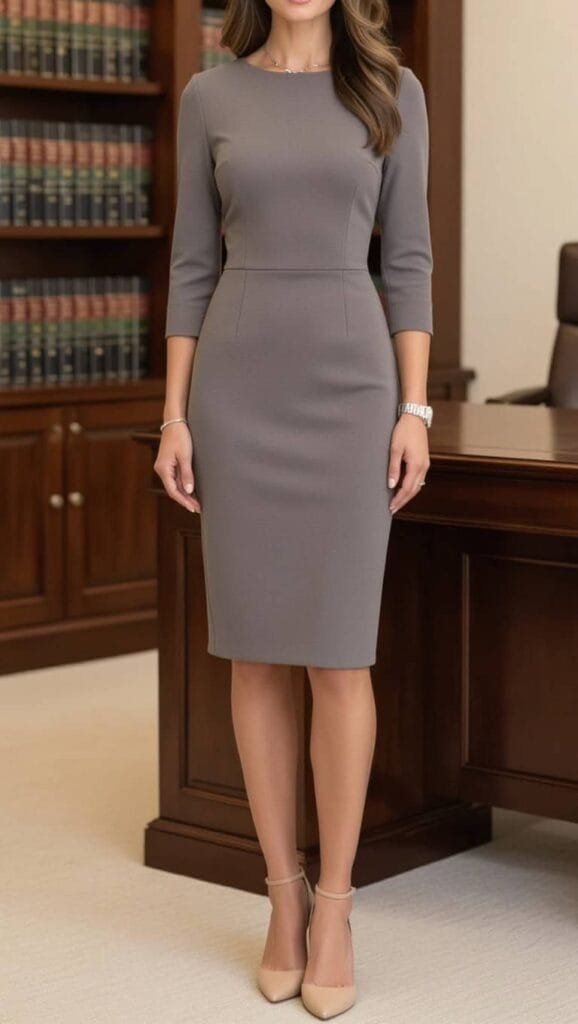
Ever tried on a dress that hugs just right? That’s the confidence boost you need when facing a judge. Avoid bold patterns or shiny fabrics; they’re too loud for the courtroom’s serious vibe. Instead, think of your suit or dress as a canvas—simple, elegant, and ready for subtle accents.
Modesty Meets Modernity: Skirts, Blouses, and Layering
Courtroom style is all about modesty with a modern twist. A knee-length A-line skirt or pencil skirt in a neutral shade pairs beautifully with a crisp blouse in white, cream, or soft blue.
4.
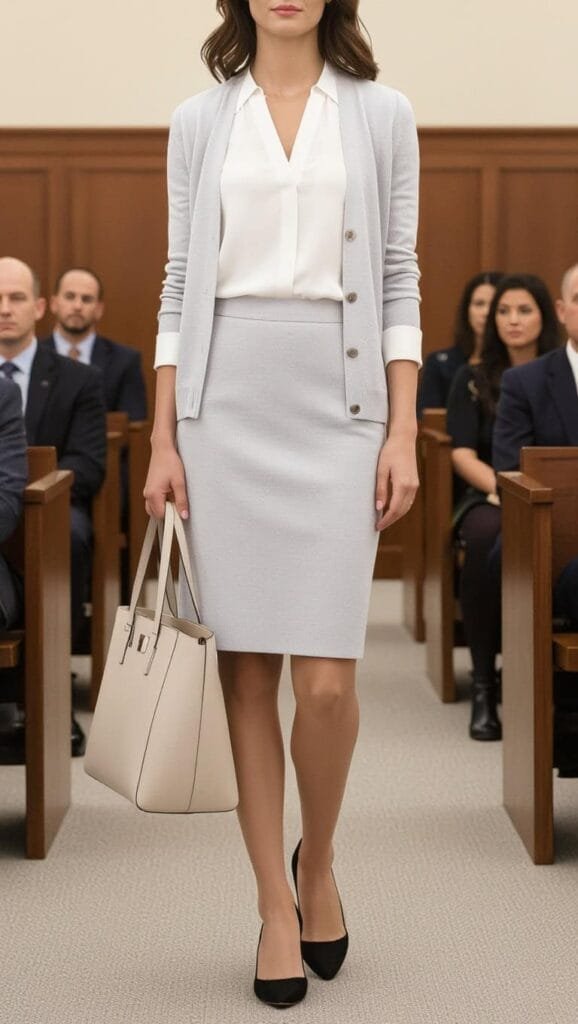
These pieces balance professionalism with approachability, showing you’re serious yet relatable. Layering is your secret weapon: a lightweight cardigan or a tailored blazer adds coverage and polish, especially if your blouse is slightly sheer. Steer clear of tight fits, plunging necklines, or loud prints—polka dots might be cute for brunch, but they’re a distraction in court. Fabrics matter too; skip anything too clingy or transparent. Imagine your outfit as a quiet conversation with the judge: respectful, composed, and never shouting for attention. Textured knits or subtle stripes can add a hint of trendiness while keeping things conservative.
Footwear and Accessories: Less Is More
Your shoes and accessories are the exclamation points of your outfit—use them sparingly. Closed-toe flats or low heels in black, nude, or navy are courtroom MVPs. They’re comfortable for long days and project understated elegance, unlike stilettos, which scream “night out” instead of “custody hearing.” Ever tripped in heels at the worst moment? Avoid that drama with sturdy, polished flats. Jewelry should be minimal: think small stud earrings, a simple watch, or a delicate chain necklace. Skip the “bling” or anything jangly—it’s distracting and risks looking frivolous. For bags, a structured tote in a neutral color holds your essentials without clashing with your look; crossbodies, while trendy, feel too casual. A sleek leather tote or a minimalist satchel keeps you organized and chic. The goal? Accessories that whisper professionalism, not shout for attention.
These wardrobe staples aren’t just clothes—they’re your armor, helping you walk into court with confidence. Mix and match a tailored blazer, a modest skirt, a crisp blouse, and subtle accessories to create a look that’s polished yet personal. Picture yourself standing tall, your outfit quietly saying, “I’m here, I’m prepared, and I’m the best mom for my child.” With these timeless pieces, you’ll nail the courtroom dress code while staying true to your style.
Latest Fashion Trends Adapted for Courtroom Appropriateness
Fashion today is bold, vibrant, and full of personality—but the courtroom calls for a softer touch. For moms preparing for a child custody hearing, blending this year’s trends with court-appropriate restraint is like painting a masterpiece with a limited palette. Let’s explore how to incorporate Spring/Summer’s hottest looks into outfits that respect the judge’s expectations while keeping you stylishly confident.
Soft Power Dressing: Spring/Summer Trends
This year, “coastal cool” and “crafty minimalism” dominate runways, and both can be tailored for the courtroom. Coastal cool brings breezy striped blouses in navy or cream—think crisp cotton button-downs tucked into tailored trousers. These stripes add a subtle nod to a nautical vibe without overwhelming the court’s conservative setting.
5.
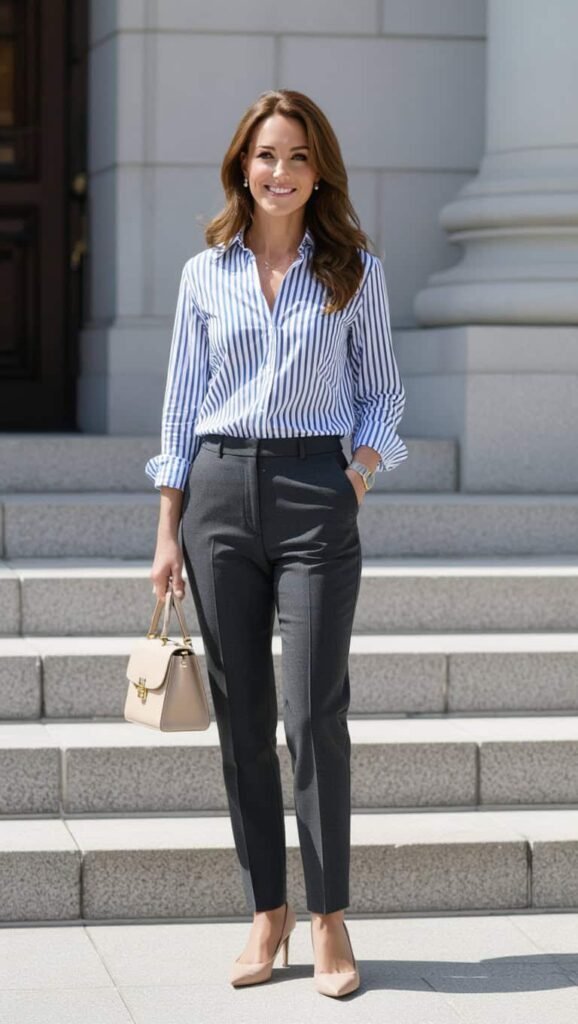
Crafty minimalism, with its textured knits and clean lines, is another gem. A lightweight, textured cardigan in a soft taupe or ivory layered over a knee-length shift dress offers warmth and sophistication, perfect for spring hearings. Structured blazers, a timeless staple, get an update in pastel hues like lavender or sage.
6.

Pair one with gray slacks for a look that’s fresh yet professional. These trends work because they balance modernity with modesty, letting you shine without stealing focus. Ever slipped on a blazer and felt instantly put-together? That’s the soft power you’re aiming for.
The key is restraint. Stick to muted versions of trendy colors and avoid anything too avant-garde. A pastel blazer is chic; a neon one screams distraction. Fabrics should be high-quality—think wool blends or breathable cotton—to keep you polished during long court sessions.
7.

Your outfit should whisper confidence, not shout for attention, aligning with the courtroom’s unspoken rule: respect the process.
Avoiding Distractions: Trendy Items to Skip
Not every trend belongs in court. Athleisure, a perennial favorite, is a hard no—yoga pants and hoodies signal casual vibes, not parental responsibility. Crop tops, another runway darling, expose too much skin and risk violating dress codes. Polka dots, while playful, are too busy for a judge’s discerning eye; they can make you look less serious. Bold accessories like chunky statement necklaces or oversized sunglasses? Save them for brunch. These items, though trendy, distract from your case and could subtly sway perceptions of your judgment. In 2024, during a session at the 187th District Court in Bexar County, Judge Stephanie Boyd ordered a mother into plastic handcuffs for appearing in shorts and using her cellphone.
Instead, pivot to safe alternatives that nod to the aesthetic. Swap polka dots for a preppy cardigan in a solid neutral, layered over a blouse for a polished look. Replace crop tops with a pleated midi skirt paired with a tucked-in silk top—elegant and trend-forward without crossing lines.
8.
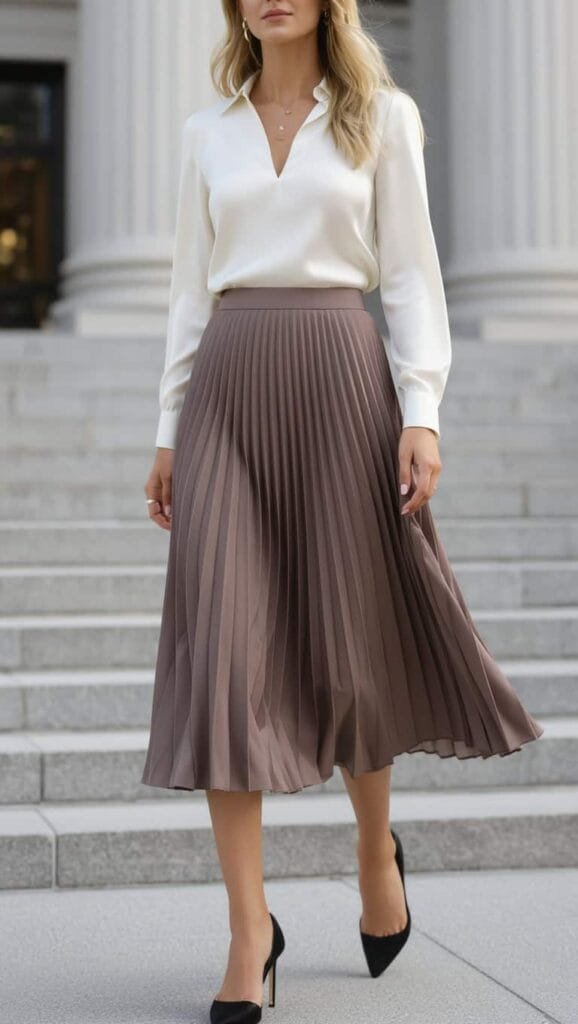
These choices keep you stylish while ensuring the judge sees you as a capable, focused parent. Courtroom fashion is about blending trends with tact, creating an outfit that’s both current and courtroom-ready. Picture yourself walking in, your subtle striped blouse and tailored blazer quietly saying, “I’m here to win this—for my child.”
Cultural and Regional Considerations for Courtroom Attire
Your courtroom outfit for a child custody hearing should reflect respect and professionalism, but cultural and regional nuances can shape what “appropriate” means.
Moms can honor their heritage or local norms while meeting the court’s expectations. Let’s dive into how to navigate these considerations with style and sensitivity.
Navigating Religious or Cultural Dress Codes
For many moms, cultural or religious attire—like hijabs, saris, or head coverings—is a core part of identity. These can absolutely work in court if styled thoughtfully. A neatly draped hijab in a neutral color like navy or cream, paired with a tailored blazer and ankle-length trousers, projects modesty and polish.
9.

Similarly, a sari in a muted tone with a simple blouse and minimal jewelry maintains elegance without overwhelming. The key? Ensure clean lines and avoid flashy embellishments that might distract.
10.
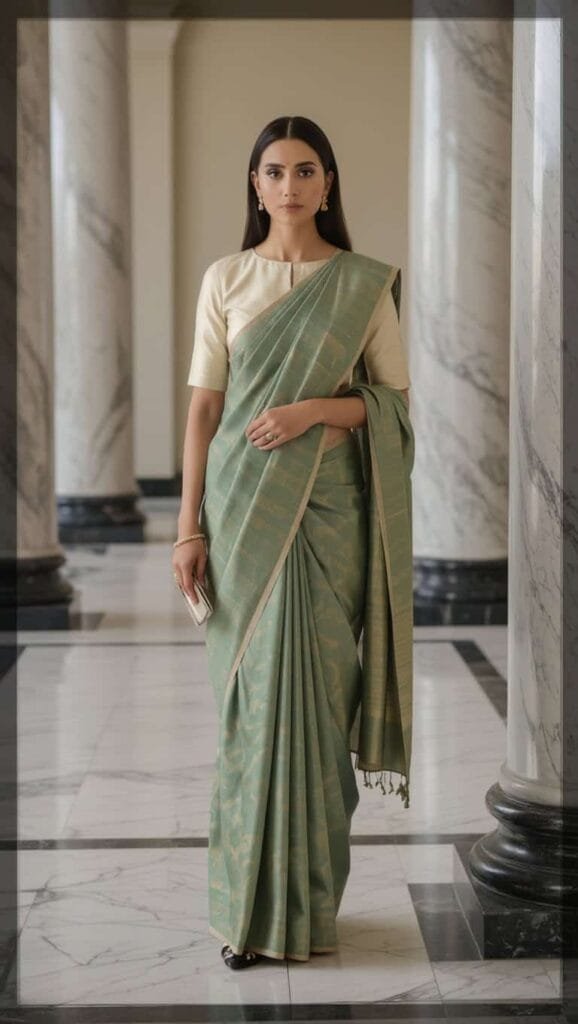
Consulting your attorney beforehand can help confirm that your attire aligns with local court guidelines. Imagine walking in, your headscarf perfectly pinned, radiating confidence and respect—it’s a powerful statement of who you are.
State-Specific Expectations: Examples from California, Texas, and New York
Courtroom norms vary by region, influenced by local culture and climate. In California’s coastal courts, like those in San Diego, judges often expect a relaxed yet polished look—think a lightweight blazer and knee-length dress in soft neutrals.
11.
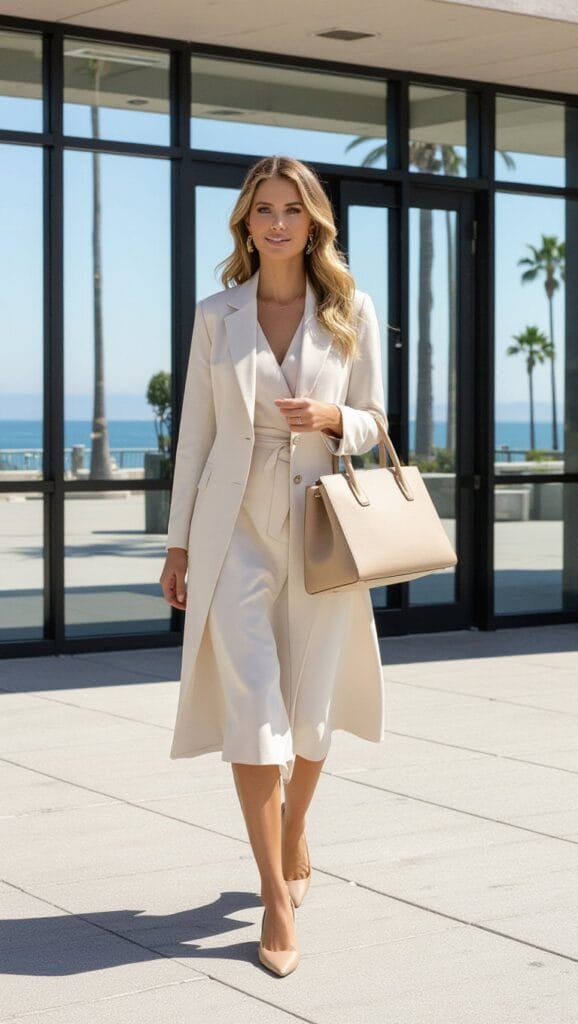
Texas courts, especially in urban Houston or Dallas, lean more formal; a structured navy suit with closed-toe flats fits the Lone Star State’s conservative vibe.
12.
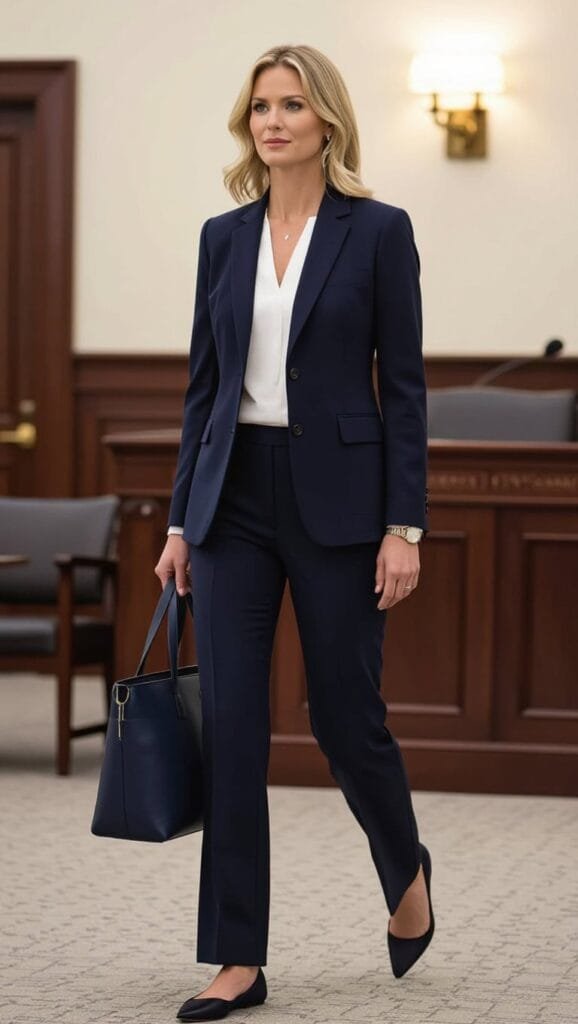
New York’s urban courts, like those in Manhattan, favor sleek sophistication—a tailored black sheath dress with a subtle cardigan works wonders.
13.

Ever wondered why some outfits feel “right” in one place but not another? It’s all about reading the room—or in this case, the region. Check with your lawyer about local expectations, and lean into pieces that feel authentic yet professional. Your outfit should say “I’m prepared” no matter the zip code, ensuring the judge focuses on your case, not your clothes.
Step-by-Step Styling Guide for Moms
Walking into a child custody courtroom can feel daunting, but your outfit can be a confidence booster. This step-by-step styling guide ensures moms look polished, professional, and ready to make their case. From pre-court prep to day-of outfit ideas, here’s how to dress like the capable parent you are.
Pre-Court Preparation: From Wardrobe to Grooming
Preparation is your secret weapon. Start a few days before by selecting your outfit and checking it’s clean, ironed, and free of stains—wrinkled clothes scream “last-minute rush.” Opt for neutral, wrinkle-resistant fabrics like wool blends or cotton; a navy blazer or knee-length dress is foolproof. Grooming matters too: keep nails trimmed and clean, and go for subtle makeup—a touch of foundation, mascara, and nude lipstick keeps it natural. Hairstyles should be neat and low-maintenance; a sleek bun, simple braid, or tucked-back waves work perfectly. Ever tried fixing a stray hair mid-hearing? Avoid that stress with a style that stays put. Lay out your outfit, shoes, and accessories the night before, and double-check with a mirror test: does this say “responsible mom”? If yes, you’re golden.
Day-of Outfit Examples
Your outfit should adapt to the season while staying court-appropriate. For a winter hearing, layer a cream turtleneck under a tailored gray blazer, paired with black trousers and closed-toe flats. This combo is warm, polished, and screams stability—perfect for a chilly courtroom.
14.
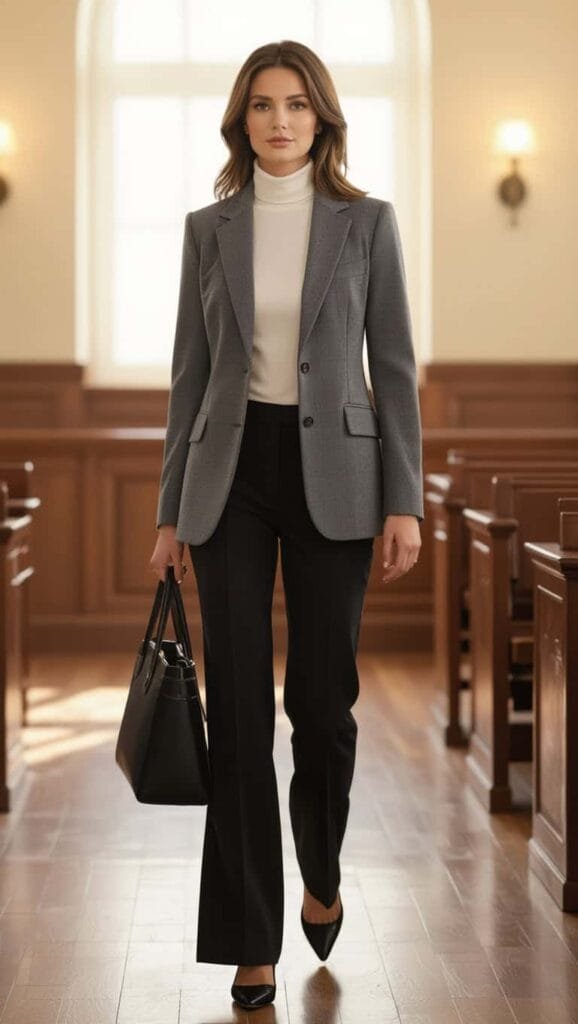
In summer, a knee-length navy shift dress with a lightweight cardigan and nude ballet flats keeps you cool yet professional. Picture yourself standing tall, your dress skimming just right, exuding calm confidence.
15.
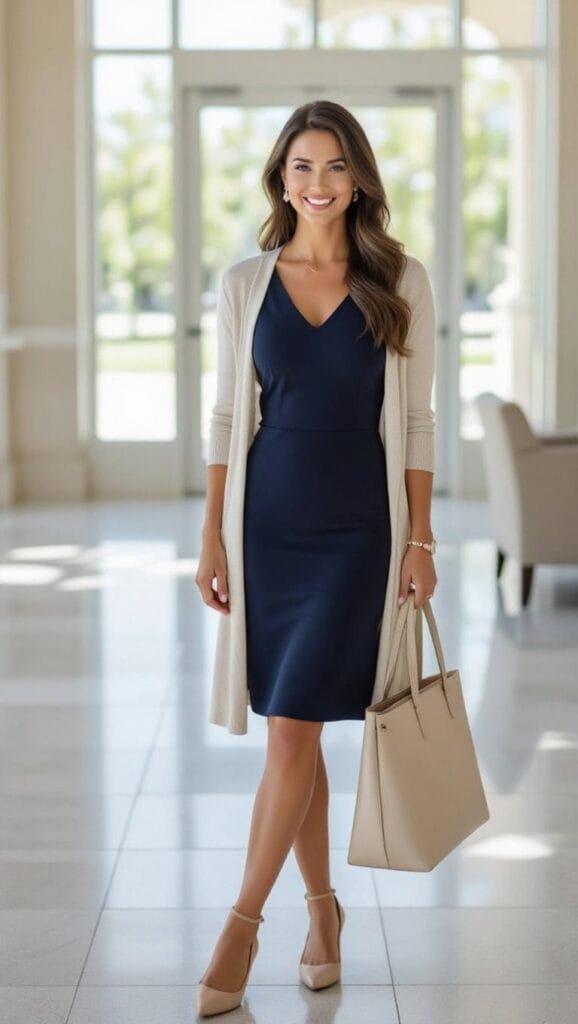
Accessories stay minimal: small stud earrings and a structured tote for documents. Avoid trends like loud stripes or flashy jewelry; they distract from your case. These outfits work because they’re simple, elegant, and let your words take center stage. Before you leave, do a final check: no loose threads, no bold scents, just you, ready to show the judge you’re the best parent for your child.
What NOT to Wear: Common Mistakes and How to Avoid Them
In a child custody courtroom, your outfit can make or break the judge’s first impression. Wearing the wrong thing isn’t just a style slip—it can signal disrespect or poor judgment. Here’s a rundown of common fashion mistakes and how to sidestep them, ensuring your look keeps the focus on your case.
Banned Items: From Casualwear to Provocative Styles
Some clothes are courtroom dealbreakers. Jeans, graphic tees, and sneakers? They’re too casual, suggesting you’re not taking the hearing seriously. Provocative choices like low-cut tops, miniskirts, or stilettos are even riskier—they can violate dress codes and paint you as irresponsible. Exposed tattoos or loud accessories, like chunky bracelets, distract from your testimony.
In 2010, a woman in Bakersfield, California, was denied entry to court for wearing flip-flops, highlighting how Comfort is tempting, but “cozy over classy” backfires when custody’s on the line. Instead, choose a tailored navy blazer, knee-length dress, or crisp blouse with trousers and formal heels. These pieces say “I’m here for business,” keeping the judge’s focus where it belongs.
Overcoming Budget Constraints: Affordable Alternatives
You don’t need a designer budget to look court-ready. Thrift stores are goldmines for quality blazers, modest dresses, and neutral skirts—often under $20. Rental services like Rent the Runway offer professional outfits for a fraction of retail cost, perfect for a one-day hearing.
Building a capsule wardrobe with versatile pieces, like a black sheath dress or gray trousers, stretches your dollar across multiple court dates.
Ever found a gem at a consignment shop? That’s your ticket to polished style on a budget. Skip fast-fashion items that look cheap or wear out fast; invest in timeless pieces that exude stability. With a little creativity, you can craft a courtroom look that’s affordable, professional, and confidence-boosting, proving you’re a capable mom without breaking the bank.
Expert Insights: Quotes from Family Law Attorneys and Stylists
When preparing for a child custody hearing, expert advice can refine your courtroom look. Family law attorneys and fashion stylists offer wisdom on how attire shapes perceptions, helping moms present their best selves with poise and purpose.
Legal Perspective: How Attire Influences Judicial Perception
Family law attorneys stress that your outfit is part of your case’s narrative.
Judges notice everything—disheveled clothing or flashy accessories can distract from your credibility. A tailored blazer and modest dress signal stability, letting your testimony shine.
Attorneys warn against casual wear like jeans. There are numerous cases where a mom’s athleisure outfit prompted a judge’s skepticism about her preparedness. Attorneys agree: your look should reflect respect for the court and your role as a parent. Think neutral tones and clean lines—less “trendy influencer,” more “reliable mom.”
Fashion Stylist Tips: Looking Polished Without Overdressing
Stylists know how to balance style and subtlety.
Court is no place for bold statements—stick to classics with a touch of elegance, advises stylists.
A silk scarf or pearl studs add polish without screaming for attention. A structured tote is recommended over a flashy handbag and muted cardigans to soften tailored suits.
A knee-length navy dress with low heels is also timeless, like a perfect coffee order.
Follow this advice to ensure you look put-together without seeming like you’re trying too hard, keeping the focus on your case.
Final Checklist and Visual Style Guide
Before you step into the courtroom for your child custody hearing, a final checklist and visual style guide will ensure your outfit hits all the right notes. These tools help moms look polished, professional, and ready to make their case with confidence.
Quick Reference: Dos and Don’ts
Your courtroom look should be a slam dunk, not a swing and a miss. Do: Wear neutral, tailored pieces like a navy blazer, knee-length dress, or crisp blouse with trousers. Opt for closed-toe flats or low heels and minimal accessories—think stud earrings or a simple watch. Ensure clothes are ironed and grooming is neat (subtle makeup, tidy hair). Don’t: Wear jeans, crop tops, stilettos, or loud patterns like polka dots. Avoid flashy jewelry or casual bags like crossbodies. Print this checklist: Outfit prepped? Shoes polished? Nails clean? If you’re nodding yes, you’re court-ready. This keeps your look focused and distraction-free.
Visual Mood Board
Picture your outfit as a calm, confident canvas. Stick to a color palette of navy, gray, cream, or black—think soothing ocean tones. Outfit inspo: a tailored gray suit with a white blouse.
16.

Or a taupe sheath dress with a soft cardigan. Add nude flats and a structured tote for polish.
17.
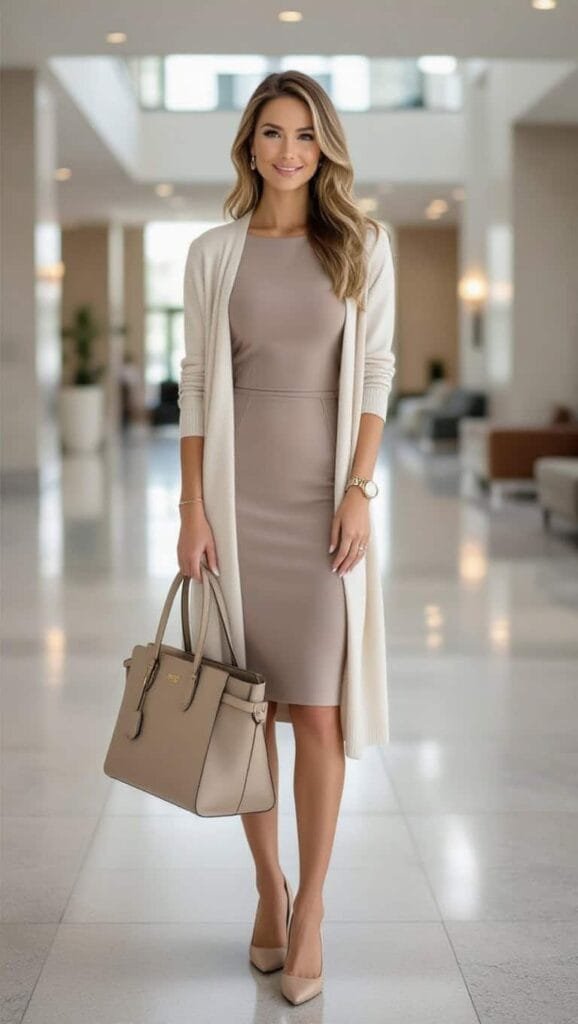
Shop court-approved retailers for timeless pieces. Ever seen a look that just works? That’s your goal: elegant, understated, and powerful. This visual guide ensures you walk in looking like the capable, dedicated mom you are, ready to shine in front of the judge.
Conclusion: Confidence Is Your Best Accessory
As you prepare for your child custody hearing, remember: your outfit is more than fabric—it’s a reflection of your strength as a mom.
A tailored navy blazer, modest dress, or crisp blouse signals respect and stability, aligning with the courtroom’s expectations. These choices let your dedication shine, keeping the focus on your case.
But the real magic? Confidence. Wear your polished look like armor, knowing you’ve honored the process while staying true to yourself. Ever felt unstoppable in the perfect outfit? That’s the vibe to channel. Step into court with your head high, your style on point, and your heart focused on your child. You’ve got this—because confidence, paired with a court-ready ensemble, is the ultimate accessory no judge can ignore.

Leave a Reply